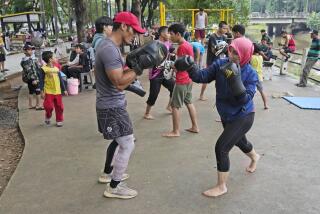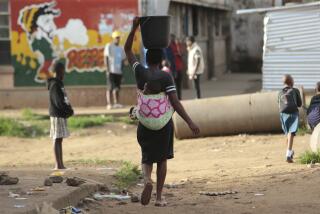THE WORLD : For Women Around the World, Survival Is Problem No. 1 : The abuse of women at home--from beating to mutilation to slavery--must end if empowerment and equality are to be achieved.
WASHINGTON — Women from all corners of the globe convene tomorrow in Beijing to discuss how to achieve empowerment and equality. It’s a daunting topic. A U.N. survey concludes that, at the current rate of progress, women will not gain economic equality until the year 2490.
Yet, the biggest problem for women begins at home, and it often boils down to simple survival.
Worldwide, at the end of the 20th Century, staggering numbers of women are still slaves, spoils of war, sexually mutilated and, most of all, victims of abuse in its many brutal forms.
The United Nations calls the trend “a global epidemic.” Indeed, if it weren’t for the credibility of the institutions that compiled the data, the numbers would almost be unbelievable.
In Peru, 70% of all reported crime involves women beaten by their husbands, says a U.N. study prepared for the Beijing conference. That figure probably doesn’t reflect the true dimensions, since most physical, sexual and especially psychological abuse goes unreported. Peru is not the exception.
In Chile, Papua New Guinea, Sri Lanka and Tanzania, at least 60% of women report being beaten or abused by a male family member or intimate. At least one of three women is beaten or abused in Malaysia, Mexico, South Korea and Zambia, according to “Violence Against Women,” a World Bank report.
Victims are not just family members. Female employees in the home are also frequent targets. In the city-state of Kuwait, hundreds of Asian domestics have fled to their embassies after being beaten by their bosses.
“Domestic violence is a leading cause of female injury in almost every country in the world and is typically ignored by the state or only erratically punished,” concludes “The Global Report on Women’s Human Rights” released today by Human Rights Watch.
Indeed, getting officialdom to pay attention to the problem often seems as difficult as getting the abusers to stop.
In South Africa, the new Prevention of Family Violence Act allows battered women to obtain restraining orders from courts. But the law is either ignored or unknown among police, lawyers and courts. Women who go to court are usually told to go home and work it out with their husbands.
During a 1991 legislative debate on rape-law reform in Malaysia, a member of the ruling party admonished that “Women should wear purdah (head-to-toe covering) to ensure that innocent men do not get unnecessarily excited by women’s bodies and are not unconsciously forced into becoming rapists.”
In Brazil, the constitution guarantees women equality before the law, but courts have exonerated men who, to protect their honor, murdered their wives for alleged adultery, Human Rights Watch reports. Yet, the honor defense has no basis in law.
In Japan, a society well known for its manners, roughly 59% of women surveyed reported physical and/or sexual abuse by a partner, according to the Domestic Violence Research Group.
One of four Canadian women claim they have been physically assaulted by a current or former male partner, while up to 4 million German women are victims of domestic violence annually, World Bank and U.N. reports document.
Abuse takes other forms besides beating or sexual attack. In India, it includes an increasing number of “dowry deaths,” the punishment meted out by in-laws when a bride brings an inadequate dowry in money and goods to her husband’s family. Since 1990, more than 20,000 brides have been killed, usually by dousing the woman with kerosene and burning her alive, the government reported in May. The figures may be low.
Worldwide, roughly 114 million women have had their genitalia mutilated, a custom imposed within families, according to the Population Council. In places such as Somalia and Djibouti, 98% of women have had their labia majora, labia minora and/or clitoris snipped, carved out or sewn up.
Burkino Faso, Sudan and Nigeria are among many African countries to outlaw what is commonly called female circumcision, a practice that probably dates back to Pharaonic times in Egypt. They have proven virtually unenforceable. Some 6,000 females still undergo genital mutilation daily--or 2 million a year--the World Bank reports. In Burkino Faso, 70% of women still undergo mutilation in defiance of laws because families believe in it.
“In Sudan, an ‘uncircumcised’ girl simply cannot find a husband. In the mind of a poor Sudanese woman, celibacy is equated quite literally with starvation,” according to Roger Kaplan of Freedom House, a human rights group.
Growing numbers of girls and women are also being lured, abducted or sold into forced prostitution and involuntary marriages, often at family initiative or with its compliance. Thousands of Nepalese, Burmese, Laotian and Thai women are sold into virtual slavery, usually as prostitutes, Human Rights Watch reports. In Thailand, they’re sold as young as age 11, after they finish sixth grade, the last year of mandatory schooling.
Perhaps the most shocking numbers are the females who don’t exist at all. Based on discrepancies in the standard male-female ratio, more than 100 million women are “missing” around the world, some 49 million in China alone, reports the 1995 U.N. Development Program survey issued two weeks ago.
Female infanticide and selective abortion of female fetuses are practices still so prevalent among families who prefer male children that regional governments in Punjab and Maharashtra imposed a ban on prenatal sex tests. Favorite infanticide techniques include feeding baby girls poisonous plant saps and choking them by lodging rice hulls soaked in milk in their throats. More than 90% of abortions performed in some parts of India are of female babies.
Why, in an era of global empowerment and two decades after the first U.N. Conference on Women in Mexico City mandated change, are most of these problems getting worse, sometimes much worse, and not better?
“Most gender-based violence against women is inextricably linked to male power, privilege and control,” concludes the U.N. study prepared for Beijing.
But the culprits are not just sexual deviants or testosterone bullies. In Canada, a judge in British Columbia suspended the sentence of a 33-year-old man convicted of sexually assaulting a 3-year-old girl with the comment, “The child was sexually aggressive.”
In fact, the problem is not strictly male attitudes and actions. Women, too, are often full or partial accomplices, whether by aborting a female fetus, allowing or urging a daughter’s circumcision, not acting when a sister, mother, cousin or aunt is abused or even by not helping herself. “Violence against women derives essentially from the lower status accorded to women in the family,” says the U.N. report.
In many countries, children are still taught--implicitly and explicitly, by women as well as men--that males are dominant or superior and violence is acceptable in asserting power and resolving conflict.
“Each society has mechanisms that legitimize, obscure, deny--and therefore perpetuate--violence. Even where a particular act of violence might be deplored, powerful social institutions--the state, families, normative systems that regulate gender relations--collude in maintaining the status quo,” conclude the authors of “Violence Against Women,” a World Bank report.
The bottom line is that women have no hope of political or economic empowerment if they have no dignity or equality at home.*
More to Read
Sign up for Essential California
The most important California stories and recommendations in your inbox every morning.
You may occasionally receive promotional content from the Los Angeles Times.










